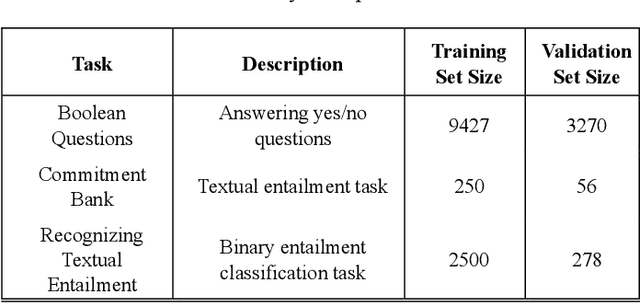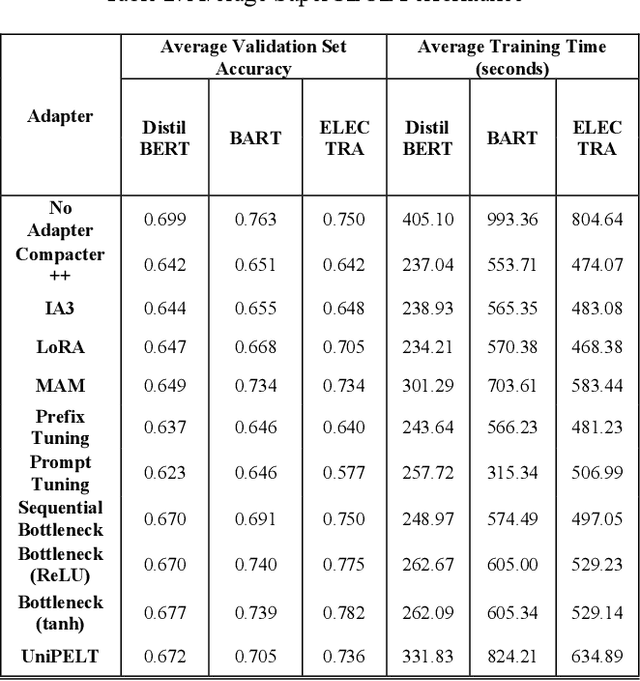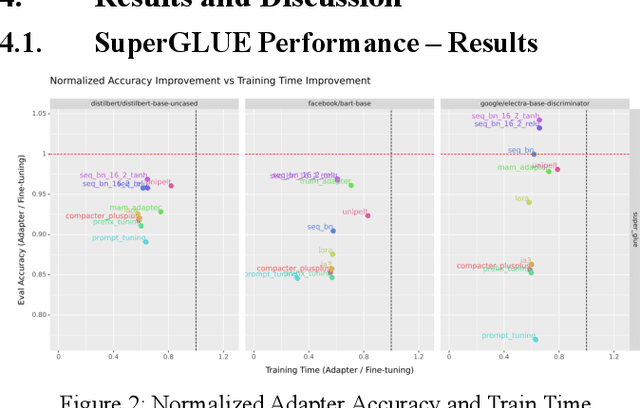Muhammad Aleem
Comparative Analysis of Efficient Adapter-Based Fine-Tuning of State-of-the-Art Transformer Models
Jan 14, 2025



Abstract:In this work, we investigate the efficacy of various adapter architectures on supervised binary classification tasks from the SuperGLUE benchmark as well as a supervised multi-class news category classification task from Kaggle. Specifically, we compare classification performance and time complexity of three transformer models, namely DistilBERT, ELECTRA, and BART, using conventional fine-tuning as well as nine state-of-the-art (SoTA) adapter architectures. Our analysis reveals performance differences across adapter architectures, highlighting their ability to achieve comparable or better performance relative to fine-tuning at a fraction of the training time. Similar results are observed on the new classification task, further supporting our findings and demonstrating adapters as efficient and flexible alternatives to fine-tuning. This study provides valuable insights and guidelines for selecting and implementing adapters in diverse natural language processing (NLP) applications.
Comparative performance analysis of the ResNet backbones of Mask RCNN to segment the signs of COVID-19 in chest CT scans
Aug 21, 2020



Abstract:COVID-19 has been detrimental in terms of the number of fatalities and rising number of critical patients across the world. According to the UNDP (United National Development Programme) Socio-Economic programme, aimed at the COVID-19 crisis, the pandemic is far more than a health crisis: it is affecting societies and economies at their core. There has been greater developments recently in the chest X-ray-based imaging technique as part of the COVID-19 diagnosis especially using Convolution Neural Networks (CNN) for recognising and classifying images. However, given the limitation of supervised labelled imaging data, the classification and predictive risk modelling of medical diagnosis tend to compromise. This paper aims to identify and monitor the effects of COVID-19 on the human lungs by employing Deep Neural Networks on axial CT (Chest Computed Tomography) scan of lungs. We have adopted Mask RCNN, with ResNet50 and ResNet101 as its backbone, to segment the regions, affected by COVID-19 coronavirus. Using the regions of human lungs, where symptoms have manifested, the model classifies condition of the patient as either "Mild" or "Alarming". Moreover, the model is deployed on the Google Cloud Platform (GCP) to simulate the online usage of the model for performance evaluation and accuracy improvement. The ResNet101 backbone model produces an F1 score of 0.85 and faster prediction scores with an average time of 9.04 seconds per inference.
 Add to Chrome
Add to Chrome Add to Firefox
Add to Firefox Add to Edge
Add to Edge